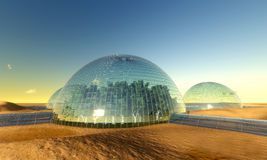Science fiction story: Where my children grow (Part 2)

Sunflowers –the pad said. Required for the production of oil for shipment to northern districts. Time of growth – 4 months. Crops should be prepared for harvest at the end of shift.
Claud inspected the Dome he just walked into. From inside, the room looked like a hollow tower. The ceiling was ovoid in shape, with a tubular structure protruding from the middle. To someone who saw it for the first time, it would look like someone had sawed off a circular area in the ceiling, and inserted a giant plastic bottle through it, bottom first. This tube, commonly known as the light-trap.
The walls of the room comprised a crisscross array of shelves, which came out of the walls sloped at an angle to the floor. They held the plants in an orientation where the leaves would get maximum exposure to the sunlight from the light trap.
The purpose of this complicated design was very simple: minimum area, maximum yield.
The solution started as a high school project that aimed to provide densely packed slums a way of lighting up their rooms. A small hole was cut into the roof, and a water bottle was entered in the hole, half of it sticking out of the hole, facing the sun. The outer portion of the bottle was wrapped with aluminium foil. The shiny metal would reflect light into the water in the bottle, and the light would be refracted and reflected by the water downwards into the room. Because of the refracting property of the water, a small hole in the roof could squeeze in a surprisingly large amount of light.
The method had its drawbacks, of course. The light could be caught only during the day. The roof tended to leak once the sealing around the bottle hardened and began to chip off. As a lighting system for slums, windows worked better. But someone decided to put the idea into farming instead.
The first Agro-dome was about fifty square meters in area, and five stories high. The top was a water reservoir cum light trap, made of toughened fiberglass, and supported by aluminium, which also reflected the light in. Inside the structure, a honeycomb structure of wooden walls containing fertilized soil provided the seeding area. A variety of crops was tried, and gave record yields of grain per area of land used.
The building in which Claud worked was a modern version of the Dome. The current one contained just sunflowers, but advanced structures could grow up to five varieties of plants. Most of the buildings were computer controlled, but each required someone to keep an eye on the plants. It was found out that a human was more likely to spot an anomaly in the crop than a computer, at least for now.
#
Claud could not complain about the workload, but had to admit that it was monotonous. But he was a natural gardener, and enjoyed working with plants. He started his day by taking a walk through the garden. He checked the plants for signs of drying up, fungi. He climbed up the ladder to different corners with a light meter and checked if some plants were getting less light than others. More light could cause the plants to wilt, and less light would result in slower growth.
This Dome was about an acre in area, and could produce the sunflower seeds equivalent to ten times the amount a normal farm of the same area could produce per year, thanks to the clever structural engineering, and the miracles of genetic engineering.
He checked his pad and ticked off light inspection. He glanced around to see if there was some anomaly in the orientation of the growth panels. They seemed all right. He decided that he would take a nap in his cabin before testing out soil samples.
The cabin was accessible by a circular hole on the floor at the center of the greenhouse. It had a small bed, a study table, a table fan on the table, and a small electric light. The moment he rested his head on his pillow, he realized that he had forgotten to bring a vital thing to work – his ebook reader.
#
Four months in near isolation, without a single thing to keep him occupied. The worry began to manifest itself. Cabin fever wasn’t uncommon for the Dome-farmers. The monotonous work for extended periods of time could give rise to an extreme case of irritability and restlessness. One way to prevent it was to keep yourself distracted, and Claud’s distraction was books.
Besides plant-wide outbreaks of chickenpox or viral fevers, cabin fever was the number one health hazard of working in the dome. Chicken pox would get you medical leave. But once you got hit by cabin fever, you had to retire. And early retirement without the retirement package meant all the years of hard work and time invested in the career gone, just like that.
“I’ll borrow one from someone tomorrow,” he thought, but he wasn’t hopeful. It was highly unlikely that someone would have a spare reader, and even more unlikely that they would share the one they had.
It was not a good idea to let stress build up. He tried to think of something else. He wondered if Bob still had the fever, but had no way of knowing. Telephones were not one of the facilities the cubicles had. There was an intercom, but that was for emergency use only. The digipad had no internet connection either. Research had found that the presence of networks in the dome had a negative correlation with crop growth. Claud did not buy this explanation, though. A more plausible explanation to him was that workers would get addicted to Farm-villa and spend less time tending the plants. But they were wrong. Books could be more addictive.
(To be continued)
Image: http://www.dreamstime.com/royalty-fre...





